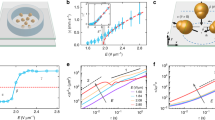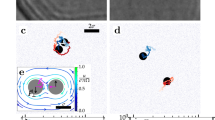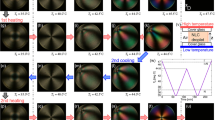Abstract
Active crystals are highly ordered structures that emerge from the self-organization of motile objects, and have been widely studied in synthetic1,2 and bacterial3,4 active matter. Whether persistent crystalline order can emerge in groups of autonomously developing multicellular organisms is currently unknown. Here we show that swimming starfish embryos spontaneously assemble into chiral crystals that span thousands of spinning organisms and persist for tens of hours. Combining experiments, theory and simulations, we demonstrate that the formation, dynamics and dissolution of these living crystals are controlled by the hydrodynamic properties and the natural development of embryos. Remarkably, living chiral crystals exhibit self-sustained chiral oscillations as well as various unconventional deformation response behaviours recently predicted for odd elastic materials5,6. Our results provide direct experimental evidence for how non-reciprocal interactions between autonomous multicellular components may facilitate non-equilibrium phases of chiral active matter.
This is a preview of subscription content, access via your institution
Access options
Access Nature and 54 other Nature Portfolio journals
Get Nature+, our best-value online-access subscription
$29.99 / 30 days
cancel any time
Subscribe to this journal
Receive 51 print issues and online access
$199.00 per year
only $3.90 per issue
Buy this article
- Purchase on Springer Link
- Instant access to full article PDF
Prices may be subject to local taxes which are calculated during checkout




Similar content being viewed by others
Data availability
All data that support the plots within this paper and other findings of this study are available from the corresponding author upon reasonable request.
Code availability
The computational methods that support the plots within this paper are described in the Supplementary Information and the underlying code is available from the corresponding author upon reasonable request.
References
Palacci, J., Sacanna, S., Preska Steinberg, A., Pine, D. J. & Chaikin, P. M. Living crystals of light-activated colloidal surfers. Science 339, 936–940 (2013).
Bililign, E. S. et al. Motile dislocations knead odd crystals into whorls. Nat. Phys. 18, 212–218 (2022).
Petroff, A. P., Wu, X.-L. & Libchaber, A. Fast-moving bacteria self-organize into active two-dimensional crystals of rotating cells. Phys. Rev. Lett. 114, 158102 (2015).
Petroff, A. P. & Libchaber, A. Nucleation of rotating crystals by Thiovulum majus bacteria. New J. Phys. 20, 015007 (2018).
Scheibner, C. et al. Odd elasticity. Nat. Phys. 16, 475–480 (2020).
Braverman, L., Scheibner, C., VanSaders, B. & Vitelli, V. Topological defects in solids with odd elasticity. Phys. Rev. Lett. 127, 268001 (2021).
Anderson, P. W. More is different. Science 177, 393–396 (1972).
Ashcroft, N. W. & Mermin, N. D. Solid State Physics (Saunders College Publishing/Harcourt College Publishers, 1976).
Li, R. & Bowerman, B. Symmetry breaking in biology. Cold Spring Harb. Perspect. Biol. 2, a003475 (2010).
Bricard, A., Caussin, J.-B., Desreumaux, N., Dauchot, O. & Bartolo, D. Emergence of macroscopic directed motion in populations of motile colloids. Nature 503, 95–98 (2013).
Grzybowski, B. A., Stone, H. A. & Whitesides, G. M. Dynamic self-assembly of magnetized, millimetre-sized objects rotating at a liquid–air interface. Nature 405, 1033–1036 (2000).
Lee, W., Amini, H., Stone, H. A. & Di Carlo, D. Dynamic self-assembly and control of microfluidic particle crystals. Proc. Natl Acad. Sci. USA 107, 22413–22418 (2010).
Naganathan, S. R., Fürthauer, S., Nishikawa, M., Jülicher, F. & Grill, S. W. Active torque generation by the actomyosin cell cortex drives left–right symmetry breaking. eLife 3, e04165 (2014).
Smith, D. J., Montenegro-Johnson, T. D. & Lopes, S. S. Symmetry-breaking cilia-driven flow in embryogenesis. Annu. Rev. Fluid Mech. 51, 105–128 (2019).
Riedel, I. H., Kruse, K. & Howard, J. A self-organized vortex array of hydrodynamically entrained sperm cells. Science 309, 300–303 (2005).
Sokolov, A., Aranson, I. S., Kessler, J. O. & Goldstein, R. E. Concentration dependence of the collective dynamics of swimming bacteria. Phys. Rev. Lett. 98, 158102 (2007).
Shen, Z., Würger, A. & Lintuvuori, J. S. Hydrodynamic self-assembly of active colloids: chiral spinners and dynamic crystals. Soft Matter 15, 1508–1521 (2019).
Bäuerle, T., Löffler, R. C. & Bechinger, C. Formation of stable and responsive collective states in suspensions of active colloids. Nat. Commun. 11, 2547 (2020).
Koch, A.-J. & Meinhardt, H. Biological pattern formation: from basic mechanisms to complex structures. Rev. Mod. Phys. 66, 1481–1507 (1994).
Wang, G. et al. Emergent field-driven robot swarm states. Phys. Rev. Lett. 126, 108002 (2021).
Omar, A. K., Klymko, K., GrandPre, T. & Geissler, P. L. Phase diagram of active brownian spheres: crystallization and the metastability of motility-induced phase separation. Phys. Rev. Lett. 126, 188002 (2021).
Avron, J. E. Odd viscosity. J. Stat. Phys. 92, 543–557 (1998).
Soni, V. et al. The odd free surface flows of a colloidal chiral fluid. Nat. Phys. 15, 1188–1194 (2019).
Banerjee, D., Vitelli, V., Jülicher, F. & Surówka, P. Active viscoelasticity of odd materials. Phys. Rev. Lett. 126, 138001 (2021).
Christina Marchetti, M. et al. Hydrodynamics of soft active matter. Rev. Mod. Phys. 85, 1143–1189 (2013).
Shankar, S., Souslov, A., Bowick, M. J., Cristina Marchetti, M. & Vitelli, V. Topological active matter. Nat. Rev. Phys.4, 380–398 (2022).
Cates, M. E. & Tailleur, J. Motility-induced phase separation. Annu. Rev. Condens. Matter Phys. 6, 219–244 (2015).
Bi, D., Lopez, J. H., Schwarz, J. M. & Manning, M. L. A density-independent rigidity transition in biological tissues. Nat. Phys. 11, 1074–1079 (2015).
Hartmann, R. et al. Emergence of three-dimensional order and structure in growing biofilms. Nat. Phys. 15, 251 (2019).
Qin, B. et al. Cell position fates and collective fountain flow in bacterial biofilms revealed by light-sheet microscopy. Science 369, 71–77 (2020).
Collinet, C. & Lecuit, T. Programmed and self-organized flow of information during morphogenesis. Nat. Rev. Mol. Cell Biol. 22, 245–265 (2021).
Rosenthal, S. B., Twomey, C. R., Hartnett, A. T., Wu, H. S. & Couzin, I. D. Revealing the hidden networks of interaction in mobile animal groups allows prediction of complex behavioral contagion. Proc. Natl Acad. Sci. USA 112, 4690–4695 (2015).
Bialek, W. et al. Statistical mechanics for natural flocks of birds. Proc. Natl Acad. Sci. USA 109, 4786–4791 (2012).
Drescher, K. et al. Dancing volvox: hydrodynamic bound states of swimming algae. Phys. Rev. Lett. 102, 168101 (2009).
Lauga, E. The Fluid Dynamics of Cell Motility (Cambridge Texts in Applied Mathematics, Cambridge Univ. Press, 2020).
Gilpin, W., Prakash, V. N. & Prakash, M. Vortex arrays and ciliary tangles underlie the feeding–swimming trade-off in starfish larvae. Nat. Phys. 13, 380–386 (2017).
Wan, K. Y. et al. Reorganization of complex ciliary flows around regenerating Stentor coeruleus. Phil. Trans. R. Soc. B 375, 20190167 (2020).
Ishikawa, T., Pedley, T. J., Drescher, K. & Goldstein, R. E. Stability of dancing Volvox. J. Fluid Mech. 903, A11 (2020).
Nelson, D. R. & Halperin, B. I. Dislocation-mediated melting in two dimensions. Phys. Rev. B 19, 2457 (1979).
Zahn, K. & Maret, G. Dynamic criteria for melting in two dimensions. Phys. Rev. Lett. 85, 3656 (2000).
Battle, C. et al. Broken detailed balance at mesoscopic scales in active biological systems. Science 352, 604–607 (2016).
Li, J., Horowitz, J. M., Gingrich, T. R. & Fakhri, N. Quantifying dissipation using fluctuating currents. Nat. Commun. 10, 1666 (2019).
Reuther, A. et al. Interactive supercomputing on 40,000 cores for machine learning and data analysis. IEEE High Perf. Ext. Comp. Conf. 1, 1–6 (2018).
Acknowledgements
We thank C. Scheibner, W. Irvine, N. Wingreen, J. Liu, Y.-C. Chao and R. E. Goldstein for valuable discussions. This research was supported by a Sloan Foundation Grant (G-2021-16758) to N.F. and J.D., and a National Science Foundation CAREER Award to N.F. T.H.T. acknowledges support from the NSF-Simons Center for Mathematical and Statistical Analysis of Biology at Harvard (award number 1764269) and Harvard Quantitative Biology Initiative as an NSF-Simons Postdoctoral Fellow. T.H.T. acknowledges support from the Center for Systems Biology Dresden as ELBE Postdoctoral Fellow. A.M. acknowledges support from a Longterm Fellowship from the European Molecular Biology Organization (ALTF 528-2019) and a Postdoctoral Research Fellowship from the Deutsche Forschungsgemeinschaft (Project 431144836). Y.C. acknowledges support from MIT Department of Physics Curtis Marble Fellowship. P.J.F. and S.G. acknowledge support from the Gordon and Betty Moore Foundation as Physics of Living Systems Fellows through grant no. GBMF4513. J.D. was supported by the Robert E. Collins Distinguished Scholarship fund. N.F., J.D. and S.G. are grateful to the KITP programme ACTIVE20: Symmetry, Thermodynamics and Topology in Active Matter, supported in part by the National Science Foundation under grant no. NSF PHY-1748958. We thank the MIT SuperCloud43 for providing access to its HPC resources.
Author information
Authors and Affiliations
Contributions
N.F., J.D., T.H.T. and A.M. conceived the project. T.H.T. and A.M. are joint first authors. J.L. and Y.C. are joint second authors. T.H.T. designed and performed experiments and analysed data. A.M. developed the theory, performed simulations and analysed data. J.L. performed experiments and analysed data. Y.C. analysed data. H.H. performed experiments. P.J.F. performed experiments and analysed data. S.G. analysed data. N.F. and J.D. designed experiments and theory and supervised research. All authors discussed the results and co-wrote the paper.
Corresponding author
Ethics declarations
Competing interests
The authors declare no competing interests.
Peer review
Peer review information
Nature thanks Vivek Prakash, Anton Souslov and the other, anonymous, reviewer(s) for their contribution to the peer review of this work.
Additional information
Publisher’s note Springer Nature remains neutral with regard to jurisdictional claims in published maps and institutional affiliations.
Supplementary information
Supplementary Information
This file contains Supplementary Sections 1 -6, including: Experiment; Theory; Data Analysis; Table of symbols; Uncropped morphology images sections and legends for the Supplementary Videos.
Rights and permissions
About this article
Cite this article
Tan, T.H., Mietke, A., Li, J. et al. Odd dynamics of living chiral crystals. Nature 607, 287–293 (2022). https://doi.org/10.1038/s41586-022-04889-6
Received:
Accepted:
Published:
Issue Date:
DOI: https://doi.org/10.1038/s41586-022-04889-6
This article is cited by
-
Shaping active matter from crystalline solids to active turbulence
Nature Communications (2024)
-
Complex motions emerge from robot interactions
Nature (2024)
-
Non-reciprocal topological solitons in active metamaterials
Nature (2024)
-
Chiral active particles are sensitive reporters to environmental geometry
Nature Communications (2024)
-
Collective motion in a sheet of microswimmers
Communications Physics (2024)
Comments
By submitting a comment you agree to abide by our Terms and Community Guidelines. If you find something abusive or that does not comply with our terms or guidelines please flag it as inappropriate.



